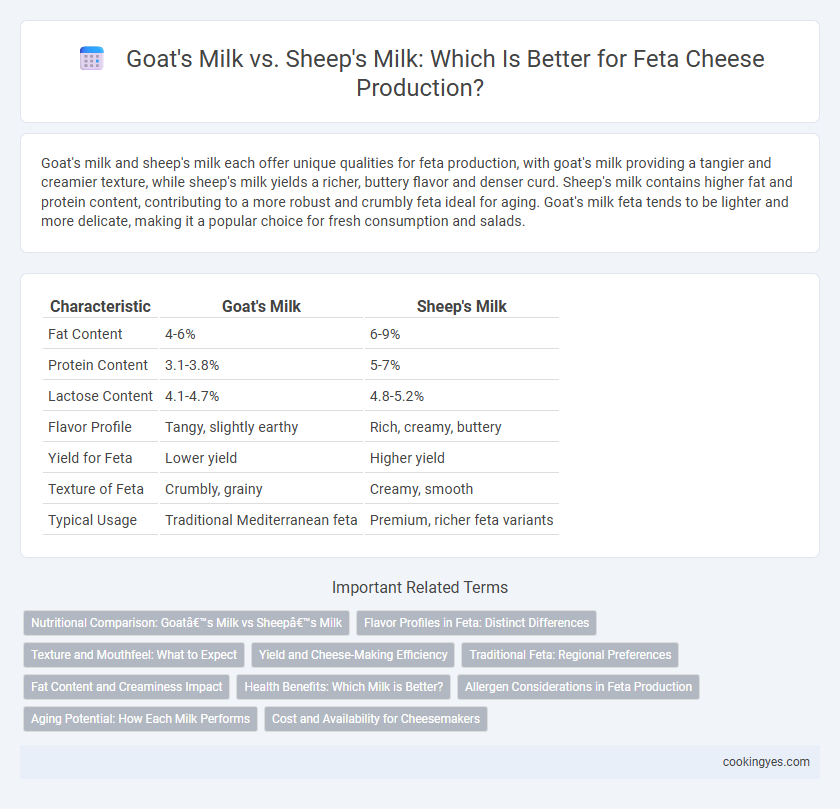Goat's milk and sheep's milk each offer unique qualities for feta production, with goat's milk providing a tangier and creamier texture, while sheep's milk yields a richer, buttery flavor and denser curd. Sheep's milk contains higher fat and protein content, contributing to a more robust and crumbly feta ideal for aging. Goat's milk feta tends to be lighter and more delicate, making it a popular choice for fresh consumption and salads.
Table of Comparison
| Characteristic | Goat's Milk | Sheep's Milk |
|---|---|---|
| Fat Content | 4-6% | 6-9% |
| Protein Content | 3.1-3.8% | 5-7% |
| Lactose Content | 4.1-4.7% | 4.8-5.2% |
| Flavor Profile | Tangy, slightly earthy | Rich, creamy, buttery |
| Yield for Feta | Lower yield | Higher yield |
| Texture of Feta | Crumbly, grainy | Creamy, smooth |
| Typical Usage | Traditional Mediterranean feta | Premium, richer feta variants |
Nutritional Comparison: Goat’s Milk vs Sheep’s Milk
Goat's milk used in feta production contains lower fat and fewer calories than sheep's milk, making it a lighter option for those monitoring caloric intake. Sheep's milk boasts a higher protein and calcium content, enhancing feta's nutritional value and contributing to a creamier texture. Both milks provide essential vitamins like B12 and minerals such as phosphorus, but sheep's milk offers a richer nutrient profile beneficial for bone health.
Flavor Profiles in Feta: Distinct Differences
Goat's milk feta offers a tangy, slightly tart flavor with earthy and grassy notes, creating a crisp and vibrant taste. Sheep's milk feta provides a richer, creamier texture with a bold, buttery, and nutty profile that enhances the depth of the cheese. These distinct flavor profiles influence feta's culinary applications, with goat's milk feta preferred for fresh salads and sheep's milk feta ideal for baking and robust dishes.
Texture and Mouthfeel: What to Expect
Goat's milk feta typically offers a creamier, tangier texture with a smooth, spreadable mouthfeel due to its higher fat content and smaller fat globules. Sheep's milk feta tends to be denser and more crumbly, providing a rich, buttery mouthfeel attributed to its higher solid content and robust protein structure. Both types deliver distinctive textures that influence the flavor release and overall eating experience in traditional Mediterranean dishes.
Yield and Cheese-Making Efficiency
Goat's milk typically produces a lower yield of feta cheese compared to sheep's milk due to its lower solids content, affecting overall cheese-making efficiency. Sheep's milk, richer in fat and protein, enhances curd formation and results in higher yield and creamier texture, making it more efficient for feta production. The increased total solids in sheep's milk lead to better coagulation and firmer curds, optimizing the cheese yield per liter processed.
Traditional Feta: Regional Preferences
Traditional Feta cheese is predominantly made from sheep's milk or a blend of sheep's and goat's milk, with regions like Greece favoring sheep's milk for its higher fat content and creamy texture. Goat's milk contributes a tangier, sharper flavor but is less commonly used alone in authentic Feta production due to its lower fat composition and distinct aromatic profile. Regional preferences reflect these differences, with northern Greek areas more inclined to incorporate goat's milk, while southern regions prioritize sheep's milk to maintain the classic rich and crumbly characteristics.
Fat Content and Creaminess Impact
Goat's milk used in feta production typically contains lower fat content than sheep's milk, resulting in a tangier and less creamy texture. In contrast, sheep's milk has higher fat levels, which enhances the feta's richness and creates a smoother, creamier mouthfeel. This difference in fat content directly influences the feta's overall creaminess and flavor profile, making sheep's milk feta more indulgent and goat's milk feta lighter and crisper.
Health Benefits: Which Milk is Better?
Goat's milk used in feta production contains smaller fat globules and higher levels of medium-chain fatty acids, which may enhance digestibility and support heart health. Sheep's milk boasts increased protein, calcium, and vitamin A content, contributing to stronger bones and improved immune function. Choosing between goat or sheep milk for feta consumption depends on individual health priorities such as digestive tolerance or nutrient density.
Allergen Considerations in Feta Production
Goat's milk and sheep's milk present differing allergen profiles crucial for feta production, with goat's milk containing less alpha-s1-casein, often resulting in lower allergenicity compared to cow's milk but still posing risks for sensitive individuals. Sheep's milk is richer in proteins and fats, potentially intensifying allergenic reactions, though it provides a creamier texture that influences the final feta quality. Understanding these allergen considerations assists producers in catering to consumer sensitivities while maintaining the authentic characteristics of traditional feta cheese.
Aging Potential: How Each Milk Performs
Goat's milk feta displays a smoother texture and a tangier flavor that tends to mellow quickly during aging, resulting in a shorter optimal aging period of around 2 to 3 months. Sheep's milk feta, richer in fat and protein, offers a denser texture and complex flavor profile that deepens significantly over extended aging periods of 6 to 9 months or more. The higher solids content in sheep's milk supports improved preservation and flavor development, making it more suitable for longer-term aging compared to goat's milk feta.
Cost and Availability for Cheesemakers
Goat's milk generally costs more than sheep's milk due to lower yield and seasonal availability, impacting feta production budgets for cheesemakers. Sheep's milk, often more abundant and consistent in supply, provides a cost-effective option for large-scale feta production while maintaining creamy texture and rich flavor. The choice between goat's and sheep's milk influences ingredient sourcing strategies, with availability often dictating production volume and price points in the feta cheese market.
Goat's Milk vs Sheep's Milk for Feta Production Infographic

 cookingyes.com
cookingyes.com